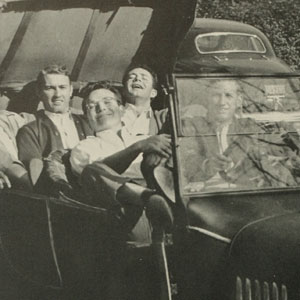
In its opening pages, the 1949 Tecoan highlighted the latest development on campus, the enrollment of men in unprecedented numbers. Several full-page pictures illustrated, with distinct male arrogance, the new gender balance. The first featured five young men stopped on Fifth Street lowering their Model-T’s convertible top. The caption related, “Most of the men were veterans, but their conversations were slowly changing from Anzio and Iwo Jima to Fords and Chevrolets and even Model T’s.” Next, the Tecoan belittled women by adding a shot of seven pajama-clad females on dorm room beds, explaining, “the girls as usual gossiped and talked about clothes.” A picture of ROTC cadets followed, standing at attention. The caption declared, “… activation of an R.O.T.C. unit on campus was a leading event of the year.” The message was men are here, wielding power with vehicles and in uniform. The campus would never be the same.
Men increasingly dominated things. They assumed power as editors-in-chief of the student newspaper, the Teco Echo; the yearbook, the Tecoan; and the literary publication, Pieces O’ Eight. The president of the Student Legislature was male. Of the eighteen ECTC students in the 1949 “Who’s Who” in American Colleges and Universities, ten were men. The College Band and Choir had strong male contingents. An all-male band, “The Collegians,” was organized and soon performed for most campus dances. The Commerce Club, the International Relations Club the Math Club, and the Neographics Club were male dominant organizations. A Veteran’s Club, then exclusively male, also made the scene. The Varsity Club, all-male, outnumbered the Women’s Athletic Association. The YMCA grew, claiming a role in YWCA activities. The football team went winless, but still attracted attention throughout the fall of 1948.
In the spring of 1949, East Carolina graduated its largest senior class ever. Its size was partially due to veterans taking advantage of GI Bill’s benefits. The president of the senior class was a male. The junior class was, according to the Tecoan, “the men’s class” because “the veterans invaded.” Both its president and vice president were men. In the sophomore class, men assumed leadership as president, vice president, and treasurer. The freshman class, the only one without a major contingent of veterans, still realized approximate gender equality in its numbers. Giving men a clean sweep, the president of the freshman class was a man.
Wilson Dorm on the west end of campus and Ragsdale on the east had earlier been converted for men but could only house a fraction of the male enrollment. The fall of 1948 brought imminent construction of a massive, three-story male dorm, with housing for 216 additional students. It was later named after Ronald James Slay, recently deceased dean of the college who had chaired the Department of Science since 1923. The new dorm was the first of several buildings funded by the state legislature in 1947, and marked the beginning of an eleven-building boom in campus growth during John D. Messick’s presidency. Yet even with it, male enrollment continued to outstrip on-campus housing for men.
East Carolina was coeducational, by charter, but never had it realized gender equality in enrollment. For four decades, it was a de facto girls’ school, with a token male presence. Changes occurred in the 1930s, but only accelerated with the late 1940s. The pivotal year was 1948-1949 when men and women enrolled in equal numbers. In achieving such diversification, East Carolina was a leader among North Carolina institutions of higher education. But it was Jim Crow gender equality, as exclusively white and segregated as before. Another two decades would pass before East Carolina realized fuller diversity built on desegregated coeducation.
Sources
- “Contracts For Men’s Dormitory Signed; Building to Begin Soon.” Teco Echo. October 22, 1948. Vol. 24, no. 3. P. 1.
- “Eighteen Students Merit Recognition in ‘Who’s Who.’” Teco Echo October 22, 1948. Vol. 24, no. 3. P. 1.
- “Jenkins Made Marine Captain.” Teco Echo. September 24, 1948. Vol. 24, no. 2. P. 1.
- “ROTC Activated For First Time.” Teco Echo. September 24, 1948. Vol. 24, no. 2. P. 1.
- Tecoan. Greenville, N.C.: East Carolina Teachers College, 1949.
- Williams, Patricia. “Dr. J.D. Messick Speaks to YWCA and YMCA.” Teco Echo. September 24, 1948. Vol. 24, no. 2. P. 1.
Citation Information
Title: Men on Campus, 1948-1949
Author: John A. Tucker, PhD
Date of Publication: 7/18/2019